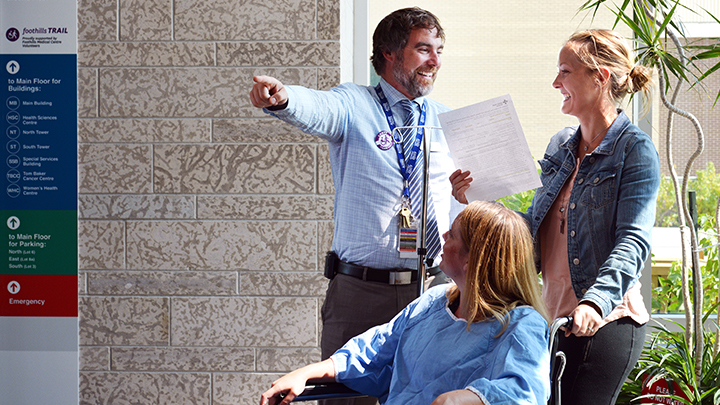
December 18, 2017

Trailblazers like Josh Bashow, Manager, Allied Health, Foothills Medical Centre, assist patients and visitors in navigating the 16 buildings spread across the site’s 84 acres.
Story by Blain Fairbairn | Photo by Quentin Collier
CALGARY — Foothills Medical Centre (FMC) covers 84 sprawling acres. When getting to appointments, work and meetings on time here becomes a challenge, the Foothills Trailblazers step up to help.
This genial group of staff, physicians or volunteers have explored — and know their site well — so they can give swift assist to patients and visitors en route to their destination.
“The implications of getting people where they need to go on time is about more than just convenience,” says Magda Mouneimne, Quality Lead, FMC Tertiary Neurorehabilitation Program and Trailblazer Committee member. “It’s also about patient safety, quality of care and efficiency.
“From a quality improvement perspective, there’s a lot of waste when people miss their appointment and don’t show up at clinics because they’re lost. It ends up impacting wait times and it could result in a health risk to the patient. If we can support the clinics in helping patients arrive on-time — that’s a huge win.”
Last year the Patient and Family Centred Care (PFCC) committee identified wayfinding at FMC as an area for improvement. At the same time, site leadership collaborated with a cross-section of stakeholders on a wayfinding program dubbed the Foothills Trail. The goal of that program was to create enhanced wayfinding signage and a single pedestrian pathway to connect all corners of the site.
When the committee group heard about the Foothills Trail program, they built upon the initiative’s branding and stakeholder engagement findings to develop a Trailblazer passport.
To become a Foothills Trailblazer, staff, physicians and volunteers must successfully find their way to each of the 25 hospital locations named in the passport. These locations were strategically chosen based upon patient and visitor demand.
Once participants have visited all the required locations, they received a distinctive Trailblazer button that invites lost patients, visitors and staff to ask them for directions.
When the passport program ran for two weeks in late September and October, 250 staff and volunteers participated. Subsequent measurement of the Trailblazer campaign and the hospital’s new wayfinding signage indicates big success.
In an online survey with 272 respondents, more than 90 per cent rated as “excellent” or “good” the quality of the new signage in helping patients and families find their destination. In a survey prior to the program, less than 30 per cent of staff described the ease of wayfinding at FMC as “good”. That figure more than doubled to 77 per cent after installation of the new signs.
Mouneimne says her feedback from Trailblazers has been positive — and she’s hopeful future initiatives will be equally successful.
“Most people told us the passport was a fun, very important and overdue exercise,” she says. “Many people also said they learned something new by travelling throughout our site, discovering places that they didn’t know existed or had ever visited before.”